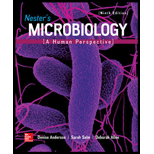
Concept explainers
Compare the impact on a society of an endemic debilitating disease with high incidence to the impact on society of a similar disease with high prevalence.
To review:
The comparison between the impact on a society with an endemic debilitating disease with high incidence and the impact on society with a similar disease with high prevalence.
Introduction:
An endemic disease refers to a disease which is persistently present in a population. For example- In the UnitedStates,the common cold is an endemic disease. An endemic debilitating disease is a disease which is constant in a population and weakens the people suffering from it.
Explanation of Solution
Both endemic debilitating disease with high incidence and disease with high prevalence have a negative impact on the society. The comparison between the two is given as under-
| Endemic debilitating disease with high incidence | Endemic debilitating disease with high prevalence |
| 1) This results in the development of new cases that means the given population is at a risk of acquiring the disease. Thus, the society is at a constant threat as new cases may emerge. | 1) This does not result in the development of new case as a given disease already exists in society and is prevalent that means the society is already suffering from this disease at a specific time. |
| 2) The emerging cases could be treated actively by developing vaccines and antibiotics. It can also be controlled by discovering the potential risk factors. Chances of recovery are there. | 2) If a society is having a prevalent disease it means that this is adversely affecting the overall health of the society. |
| 3) The status of a person may change from ill to healthy. So, one needs to be careful while taking the new emerging cases into account. | 3) Both old and new cases present in society is taken into account. |
| 4) The diseased person is often recovered. | 4) This results in recovery, migration or death. |
Thus, it can be concluded that both endemic debilitating diseases with high incidence and prevalence severely affects the society. As seen in the increasing incidence of newly emerging diseases, it can be controlled by tracing the source of infection but as prevalent diseases are already present in society it may lead to death, recovery or migration.
Want to see more full solutions like this?
Chapter 19 Solutions
Nester's Microbiology: A Human Perspective
- What is the result of the following gram stain: positive ○ capsulated ○ acid-fast ○ negativearrow_forwardWhat type of stain is the image below: capsule stain endospore stain gram stain negative stain ASM MicrobeLibrary.org Keplingerarrow_forwardWhat is the result of the acid-fast stain below: Stock Images by Getty Images by Getty Images by Getty Images by Getty Image Getty Images St Soy Getty Images by Getty Images by Getty Images Joy Getty encapsulated O endosporulating negative ○ positivearrow_forward
- You have a stock vial of diligence 75mg in 3ml and need to draw up a dose of 50mg for your patient.how many mls should you draw up to give this dosearrow_forwardYou are recquired to administer 150mg hydrocortisone intravenously,how many mls should you give?(stock =hydrocortisone 100mg in 2mls)arrow_forwardIf someone was working with a 50 MBq F-18 source, what would be the internal and external dose consequences?arrow_forward
- We will be starting a group project next week where you and your group will research and ultimately present on a current research article related to the biology of a pathogen that infects humans. The article could be about the pathogen itself, the disease process related to the pathogen, the immune response to the pathogen, vaccines or treatments that affect the pathogen, or other biology-related study about the pathogen. I recommend that you choose a pathogen that is currently interesting to researchers, so that you will be able to find plenty of articles about it. Avoid choosing a historical disease that no longer circulates. List 3 possible pathogens or diseases that you might want to do for your group project.arrow_forwardnot use ai pleasearrow_forwardDNK dagi nukleotidlar va undan sintezlangan oqsildagi peptid boglar farqi 901 taga teng bo'lib undagi A jami H boglardan 6,5 marta kam bo'lsa DNK dagi jami H bog‘lar sonini topingarrow_forward
- One of the ways for a cell to generate ATP is through the oxidative phosphorylation. In oxidative phosphorylation 3 ATP are produced from every one NADH molecule. In respiration, every glucose molecule produces 10 NADH molecules. If a cell is growing on 5 glucose molecules, how much ATP can be produced using oxidative phosphorylation/aerobic respiration?arrow_forwardIf a cell is growing on 5 glucose molecules, how much ATP can be produced using oxidative phosphorylation/aerobic respiration?arrow_forwardHow do i know which way the arrows go?arrow_forward
 Medical Terminology for Health Professions, Spira...Health & NutritionISBN:9781305634350Author:Ann Ehrlich, Carol L. Schroeder, Laura Ehrlich, Katrina A. SchroederPublisher:Cengage LearningHealth Safety And Nutrition F/Young ChildHealth & NutritionISBN:9781305144767Author:MAROTZPublisher:CengageCase Studies In Health Information ManagementBiologyISBN:9781337676908Author:SCHNERINGPublisher:Cengage
Medical Terminology for Health Professions, Spira...Health & NutritionISBN:9781305634350Author:Ann Ehrlich, Carol L. Schroeder, Laura Ehrlich, Katrina A. SchroederPublisher:Cengage LearningHealth Safety And Nutrition F/Young ChildHealth & NutritionISBN:9781305144767Author:MAROTZPublisher:CengageCase Studies In Health Information ManagementBiologyISBN:9781337676908Author:SCHNERINGPublisher:Cengage Comprehensive Medical Assisting: Administrative a...NursingISBN:9781305964792Author:Wilburta Q. Lindh, Carol D. Tamparo, Barbara M. Dahl, Julie Morris, Cindy CorreaPublisher:Cengage Learning
Comprehensive Medical Assisting: Administrative a...NursingISBN:9781305964792Author:Wilburta Q. Lindh, Carol D. Tamparo, Barbara M. Dahl, Julie Morris, Cindy CorreaPublisher:Cengage Learning





